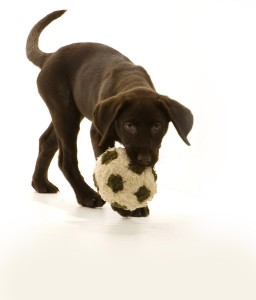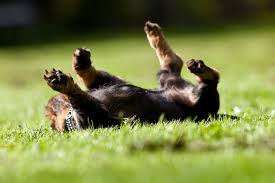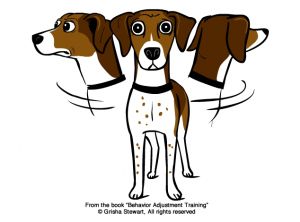
[s2If current_user_cannot(access_s2member_ccap_course_003_ep)]
We have made this lesson public because the information is so critical. To view other lessons, please purchase the Empowered Puppy Raising course or log in if you have already purchased it.[/s2If]
If you have a puppy (or a young animal of any species), socialization should be your main focus in the weeks and months to come. This whole course is designed with socialization and essential skills in mind, but if you can’t keep up with the homework in the class, just focus on socialization. Skills can wait.
Puppy socialization is low-stress exposure to various aspects of everyday life – people, dogs, surfaces, noises, etc. Always make sure it’s not a stressful event and that your puppy has as much control over her experience of the situation as possible. (Dog geeks: socialization is officially just with other animals but has come to mean more).
Puppies that are not well-socialized often have problems with aggression, fear, or manners later. Under-socialized dogs are often not comfortable with the world they live in and are less able to cope with change than they should be. Many dogs at the shelter that look abused were actually just under-socialized as puppies. People are often afraid of the germs that their puppy might encounter when they are out in the world, but the major killer of dogs in the U.S. is not disease, it’s behavior, which is directly correlated to puppy socialization. For most of the dogs, that could have been changed with early socialization and puppy training.
[vc_video link=”https://vimeo.com/121312349″]
 Socialize your puppy now in a positive way. Because of our current understanding of the importance of behavior, and because of vaccine advancements, we start socializing puppies earlier than we used to.
Socialize your puppy now in a positive way. Because of our current understanding of the importance of behavior, and because of vaccine advancements, we start socializing puppies earlier than we used to.
Most of the new puppy vaccines can be given starting at 6 weeks old, and start being effective for relatively clean environments about 10 days later. Previous vaccines would fight with the immunization given by the mother and thus lose effectiveness, but newer vaccines have solved this problem, so we can vaccinate earlier than we could years ago.
After your puppy gets his first round of shots, he is ready to be carefully exposed to the world. We still need to minimize risks for disease until the vaccinations are complete (usually 3 sets of combo shots) and keep the socialization fun for your puppy. That’s the key to everything – socialization is a fun, confidence-building experience for your puppy.
The American Veterinary Society of Animal Behavior recommends starting puppy classes 7 days after your puppy’s first set of shots, in most cases. Click here for the AVSAB position statement (PDF). Another veterinarian’s opinion on puppy socialization is provided by Dr. R.K. Anderson.
“The primary and most important time for puppy socialization is the first three months of life. During this time puppies should be exposed to as many new people, animals, stimuli and environments as can be achieved safely and without causing overstimulation manifested as excessive fear, withdrawal or avoidance behavior. For this reason, the American Veterinary Society of Animal Behavior believes that it should be the standard of care for puppies to receive such socialization before they are fully vaccinated” – AVSAB
Trainer Note: If you run a training school, be sure to keep your facility clean so that it is safe for the puppies. When I owned Ahimsa Dog Training in Seattle, we had about 12 puppy classes each week. We worked hard to keep medical and emotional risks to a minimum. We had the facility professionally cleaned with a virucide the night before each puppy class, ask all puppy owners for proof of vaccination and urged them to keep their puppies’ vaccinations up to date. We also required our students to avoid the dog park while they are enrolled in puppy class.
Your puppy is learning and socializing right now, every second that she’s awake. People used to say that you couldn’t start obedience training with a puppy until it was six months old. But they meant you couldn’t properly punish a dog until that age with a choke chain, because of their growing puppy bones. With positive training methods, you don’t have to wait. Using positive training, some dog breeders send home puppies that already know how to sit on cue. That’s just one more reason to be dog-friendly – you can teach your puppy manners now! You can and should start teaching your puppy basic cues, like sit, down, etc. using a clicker or just using treats and praise. But your main focus during puppyhood should not be on manners or ‘obedience’, but rather on socialization with other puppies, dogs, humans, surfaces, sounds, and more.
Puppies are socialization sponges. First impressions are strong, events that they experience in this time period (especially scary ones) will stick with them forever. Sources differ, but many say that the primary socialization period is up until 12 weeks . From 12-16 weeks, they are learning as well, but not as quickly as they did up to 12 weeks. Every new experience for your puppy should be positive — accompanied by treats, praise, and/or fun. Up until 6 months, you should only have your puppy in socializing environments that you have solid control over.
Socialize with dogs in a force-free puppy training class, a puppy play group, or a neighbor’s yard, not the dog park! One recent study found that dogs about 6 month of age were the target for the most aggression in the park, more than any other age group. Once your dog is old enough to go to the dog park, and you decide it’s worth the risk, protect him from harm by moving along, not letting him get harassed by other dogs, etc. If you have a small breed dog, you should probably wait even longer than six months. There are opportunities for play and socialization outside of the park, and you should take advantage of them.
Many people are surprised to learn that the full socialization period for a puppy is two years! But your dog will be your companion for 10 to 15 more years! Why not invest some time in her now?

What sort of things should you socialize your new puppy to? Everything!! Your puppy should experience a bit of cold, funny noises, strange hats, interesting textures, calm restraint (praise and release it when puppy is calm, but let go immediately if puppy is scared), other dogs (your own dogs are not enough!) and many other things.
Puppies should also learn to stop mouthing, gradually. All of these topics in a good puppy socialization class, but you should start with exposing your puppy to new things now. Socialization doesn’t just mean play.
Take a look at the Puppy’s Rule of Twelve by Margaret Hughes for some ideas:
The Puppy’s Rule of Twelve (adapted)
Positive Paws Dog Training ©2002 – Margaret Hughes
Adapted with permission from Pat Schaap’s “RULE OF 7’s” for 7 week old puppies
(If your puppy is over 12 weeks start right away with this socialization guide.)
Make sure all experiences are safe and positive for the puppy. Each encounter should include treats and lots of praise, and your puppy should be able to leave whenever s/he wants. Slow down and add distance if your puppy is scared!
By the time a puppy is 12 weeks old, it should have:
- Experienced 12 different surfaces: wood, wood chips, carpet, tile, cement, linoleum, grass, wet grass, dirt, mud, puddles, deep pea gravel, grates, uneven surfaces, on a table, on a chair, etc……
- Played with 12 different objects: fuzzy toys, big & small balls, hard toys, funny sounding toys, wooden items, paper or cardboard items, milk jugs, metal items, car keys, etc…….
- Experienced 12 different locations: front yard (daily), other people’s homes, school yard, lake, pond, river, boat, basement, elevator, car, moving car, garage, laundry room, kennel, veterinarian hospital (stop by sometimes just to say hi & visit, lots of cookies, no vaccinations), grooming salon (just to say hi), etc….
- Met and enjoyed being with / played with 12 new people (outside of family): include children, adults (mostly men), elderly adults, people in wheelchairs, walkers, people with canes, crutches, hats, sunglasses, etc….
- Heard 12 different noises (ALWAYS keep positive and watch puppy’s comfort level – we don’t want the puppy scared): garage door opening, doorbell, children playing, babies screaming, big trucks, Harley motorcycles, skateboards, washing machine, shopping carts rolling, power boat, clapping, loud singing, pan dropping, horses neighing, vacuums, lawnmowers, birthday party, etc…
- Seen 12 fast moving objects (don’t allow chasing): skateboards, roller-skates, bicycles, motorcycles, cars, people running, cats running, scooters, vacuums, children running, children playing soccer, squirrels, cats, horses running, cows running, etc…
- Experienced 12 different challenges: climb on, in, off and around a box, go through a cardboard tunnel, climb up and down steps, climb over obstacles, play hide & seek, go in and out a doorway with a step up or down, exposed to an electric sliding door, umbrella, balloons, walk on a wobbly table (plank of wood with a small rock underneath), jump over a broom, climb over a log, bathtub (and bath) etc….
- Been handled by owner 12 times a week (only do as much as puppy is comfortable with): hold under arm (like a football), hold to chest, hold on floor near owner, hold in-between owner’s legs, hold head, look in ears, mouth, in-between toes, hold and take temperature (ask veterinarian), hold like a baby, trim toe nails, hold in lap, etc… Note: get the puppy’s cooperation here whenever possible and treat a lot. Add predictability by saying what you are about to do (for example “Ears” – touch ear – treat). If the puppy moves away, you’re pushing too quickly. Back it up and work at the puppy’s pace.
- Eaten from 12 different shaped containers: wobbly bowl, metal, cardboard box, paper, coffee cup, china, pie plate, plastic, frying pan, Kong, Treatball, Bustercube, spoon fed, paper bag, etc……
- Eaten in 12 different locations: back yard, front yard, crate, kitchen, basement, laundry room, bathroom, friend’s house, car, school yard, bathtub, up high (on work bench), under umbrella, etc….
- Made 12 different dog friends (puppies or safe adult dogs). [This does NOT mean at the dog park and it doesn’t always mean rough and tumble play, although should be part of it.]
- Been alone safely, away from family and other animals (5-45 minutes) 12 times a week.
- Experienced a leash and harness 12 different times in 12 different locations.
I also wanted to add ‘walked in the dark 12 times’ but that seems like a lot for the first 12 weeks. Do at least walk your puppy in the dark 12 times in the first 6 months. And socialization does not end at 12 weeks. Continue helping your dog have positive experiences throughout their first 2 years and then maintain some level of socialization throughout your dog’s life.